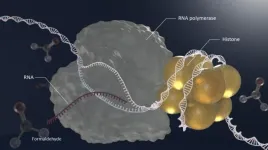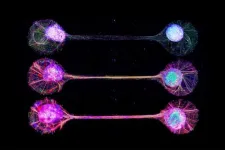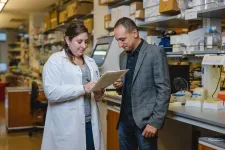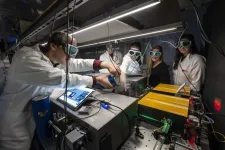(Press-News.org) Researchers at the National Institutes of Health applied artificial intelligence (AI) to a technique that produces high-resolution images of cells in the eye. They report that with AI, imaging is 100 times faster and improves image contrast 3.5-fold. The advance, they say, will provide researchers with a better tool to evaluate age-related macular degeneration (AMD) and other retinal diseases.
“Artificial intelligence helps overcome a key limitation of imaging cells in the retina, which is time,” said Johnny Tam, Ph.D., who leads the Clinical and Translational Imaging Section at NIH's National Eye Institute.
Tam is developing a technology called adaptive optics (AO) to improve imaging devices based on optical coherence tomography (OCT). Like ultrasound, OCT is noninvasive, quick, painless, and standard equipment in most eye clinics.
Imaging RPE cells with AO-OCT comes with new challenges, including a phenomenon called speckle. Speckle interferes with AO-OCT the way clouds interfere with aerial photography. At any given moment, parts of the image may be obscured. Managing speckle is somewhat similar to managing cloud cover. Researchers repeatedly image cells over a long period of time. As time passes, the speckle shifts, which allows different parts of the cells to become visible. The scientists then undertake the laborious and time-consuming task of piecing together many images to create an image of the RPE cells that's speckle-free.
Tam and his team developed a novel AI-based method called parallel discriminator generative adverbial network (P-GAN)—a deep learning algorithm. By feeding the P-GAN network nearly 6,000 manually analyzed AO-OCT-acquired images of human RPE, each paired with its corresponding speckled original, the team trained the network to identify and recover speckle-obscured cellular features.
When tested on new images, P-GAN successfully de-speckled the RPE images, recovering cellular details. With one image capture, it generated results comparable to the manual method, which required the acquisition and averaging of 120 images. With a variety of objective performance metrics that assess things like cell shape and structure, P-GAN outperformed other AI techniques. Vineeta Das, Ph.D., a postdoctoral fellow in the Clinical and Translational Imaging Section at NEI, estimates that P-GAN reduced imaging acquisition and processing time by about 100-fold. P-GAN also yielded greater contrast, about 3.5 greater than before.
“Adaptive optics takes OCT-based imaging to the next level,” said Tam. “It’s like moving from a balcony seat to a front row seat to image the retina. With AO, we can reveal 3D retinal structures at cellular-scale resolution, enabling us to zoom in on very early signs of disease.”
While adding AO to OCT provides a much better view of cells, processing AO-OCT images after they’ve been captured takes much longer than OCT without AO.
Tam’s latest work targets the retinal pigment epithelium (RPE), a layer of tissue behind the light-sensing retina that supports the metabolically active retinal neurons, including the photoreceptors. The retina lines the back of the eye and captures, processes, and converts the light that enters the front of the eye into signals that it then transmits through the optic nerve to the brain. Scientists are interested in the RPE because many diseases of the retina occur when the RPE breaks down.
By integrating AI with AO-OCT, Tam believes that a major obstacle for routine clinical imaging using AO-OCT has been overcome, especially for diseases that affect the RPE, which has traditionally been difficult to image.
“Our results suggest that AI can fundamentally change how images are captured,” said Tam. “Our P-GAN artificial intelligence will make AO imaging more accessible for routine clinical applications and for studies aimed at understanding the structure, function, and pathophysiology of blinding retinal diseases. Thinking about AI as a part of the overall imaging system, as opposed to a tool that is only applied after images have been captured, is a paradigm shift for the field of AI.”
More news from the NEI Clinical and Translational Imaging Section.
Reference:
Vineeta Das, Furu Zhang, Andrew Bower, et al. Revealing speckle obscured living human retinal cells with artificial intelligence assisted adaptive optics optical coherence tomography. Communications Medicine. April 10, 2024, https://doi.org/10.1038/s43856-024-00483-1.
This press release describes a basic research finding. Basic research increases our understanding of human behavior and biology, which is foundational to advancing new and better ways to prevent, diagnose, and treat disease. Science is an unpredictable and incremental process— each research advance builds on past discoveries, often in unexpected ways. Most clinical advances would not be possible without the knowledge of fundamental basic research. To learn more about basic research, visit https://www.nih.gov/news-events/basic-research-digital-media-kit.
NEI leads the federal government’s efforts to eliminate vision loss and improve quality of life through vision research…driving innovation, fostering collaboration, expanding the vision workforce, and educating the public and key stakeholders. NEI supports basic and clinical science programs to develop sight-saving treatments and to broaden opportunities for people with vision impairment. For more information, visit https://www.nei.nih.gov.
About the National Institutes of Health (NIH): NIH, the nation’s medical research agency, includes 27 Institutes and Centers and is a component of the U.S. Department of Health and Human Services. NIH is the primary federal agency conducting and supporting basic, clinical, and translational medical research, and is investigating the causes, treatments, and cures for both common and rare diseases. For more information about NIH and its programs, visit https://www.nih.gov/.
NIH…Turning Discovery Into Health®
END
AI makes retinal imaging 100 times faster, compared to manual method
NIH scientists use artificial intelligence called ‘P-GAN’ to improve next-generation imaging of cells in the back of the eye
2024-04-10
ELSE PRESS RELEASES FROM THIS DATE:
Impact of aldehydes on DNA damage and aging
2024-04-10
A team of researchers at Nagoya University in Japan has discovered that aldehydes are metabolic byproducts associated with premature aging. Published in Nature Cell Biology, their findings reveal insights into premature aging diseases and potential strategies to combat aging in healthy individuals such as controlling exposure to aldehyde-inducing substances including alcohol, pollution, and smoke.
A person's health can be harmed by aldehydes. However, the group’s findings suggest these detrimental effects also include aging. The team who made this discovery included Yasuyoshi Oka, Yuka Nakazawa, Mayuko Shimada, and Tomoo Ogi of Nagoya University.
“DNA ...
New method of measuring qubits promises ease of scalability in a microscopic package
2024-04-10
Chasing ever-higher qubit counts in near-term quantum computers constantly demands new feats of engineering.
Among the troublesome hurdles of this scaling-up race is refining how qubits are measured. Devices called parametric amplifiers are traditionally used to do these measurements. But as the name suggests, the device amplifies weak signals picked up from the qubits to conduct the readout, which causes unwanted noise and can lead to decoherence of the qubits if not protected by additional large components. More importantly, the bulky size of the amplification chain becomes technically challenging to work around as qubit counts increase ...
Study shedding new light on Earth’s global carbon cycle could help assess liveability of other planets
2024-04-10
Research has uncovered important new insights into the evolution of oxygen, carbon, and other vital elements over the entire history of Earth – and it could help assess which other planets can develop life, ranging from plants to animals and humans.
The study, published today in Nature Geoscience and led by a researcher at the University of Bristol, reveals for the first time how the build up of carbon-rich rocks has accelerated oxygen production and its release into the atmosphere. Until now the exact nature of how the atmosphere became oxygen-rich has long eluded scientists and generated conflicting explanations.
As carbon dioxide is steadily ...
Connecting lab-grown brain cells provides insight into how our own brains work
2024-04-10
Tokyo, Japan – The idea of growing a functioning human brain-like tissues in a dish has always sounded pretty far-fetched, even to researchers in the field. Towards the future goal, a Japanese and French research team has developed a technique for connecting lab-grown brain-mimicking tissue in a way that resembles circuits in our brain.
It is challenging to study exact mechanisms of the brain development and functions. Animal studies are limited by differences between species in brain structure and function, and brain cells grown in the lab tend to lack the characteristic ...
Breakthrough for next-generation digital displays
2024-04-10
Researchers at Linköping University, Sweden, have developed a digital display screen where the LEDs themselves react to touch, light, fingerprints and the user’s pulse, among other things. Their results, published in Nature Electronics, could be the start of a whole new generation of displays for phones, computers and tablets.
“We’ve now shown that our design principle works. Our results show that there is great potential for a new generation of digital displays where new advanced ...
Wistar scientists identify pro-aging ‘sugar signature’ in the blood of people living with HIV
2024-04-10
PHILADELPHIA — (April 10, 2024) — The Wistar Institute’s associate professor Mohamed Abdel-Mohsen, Ph.D., along with his team and collaborators, has identified sugar abnormalities in the blood that may promote biological aging and inflammation in people living with HIV (PLWH). The findings, taken from a large data study comprising more than 1200 participants, are detailed in the new paper, “Immunoglobulin G N-glycan Markers of Accelerated Biological Aging During Chronic HIV Infection,” published in the journal Nature Communications.
Despite advances ...
CAMH develops first ever clinically validated natural supplement to prevent postpartum blues
2024-04-10
A new study published in the Lancet discovery science journal eClinicalMedicine has confirmed that a novel natural supplement—invented, researched, developed and commercialized at the Centre for Addiction and Mental Health (CAMH)—prevents postpartum blues, and reduces symptoms of postpartum depression over the following six months after giving birth.
Up to 8 out of ten new mothers experience postpartum, or ‘baby,’ blues, characterized by mood swings, crying spells, anxiety and difficulty sleeping. The condition usually begins within the first few days after delivery and may last for up to two weeks. Postpartum ...
Breakthroughs in durable mechanical circulatory support (MCS) devices add years to lives and life to years for heart failure patients
2024-04-10
Embargoed until 10:00 a.m. Wednesday, 10 April, 2024 Central European Summer Time (GMT +2)
10 April, 2024, Prague, Czech Republic—The same technology that enables a bullet train to travel at speeds up to 200 mph without touching its rails now keeps a failing heart pumping—and in the near future, it will do so via a wireless power connection. Mandeep R. Mehra, MD, FRCP described the cutting-edge heart pump and other advances in mechanical circulatory support (MCS) today at the Annual Meeting and Scientific Sessions of the International Society for Heart and Lung Transplantation (ISHLT) in ...
AI will provide heart transplant surgeons with new decision-making data
2024-04-10
Embargoed until 10:00 a.m., Wednesday, 10 April, 2024 Central European Summer Time (GMT +2)
10 April 2024, Prague, Czech Republic—Artificial intelligence will significantly impact the heart transplantation process by helping physicians better assess the complex factors impacting patient outcomes, according to researchers at today’s Annual Meeting and Scientific Sessions of the International Society of Heart and Lung Transplantation (ISHLT) in Prague.
“Until now, we’ve assessed the likelihood of transplant success based on individual risk factors,” said Eileen Hsich, medical director of the Heart Transplant Program at the Cleveland ...
Novel UV broadband spectrometer revolutionizes air pollutant analysis
2024-04-10
Sunlight has a major influence on chemical processes. Its high-energy UV radiation in particular is strongly absorbed by all materials and triggers photochemical reactions of the substances present in the air. A well-known example is the formation of ground-level ozone when UV light hits nitrogen oxides. A research team led by Birgitta Schultze-Bernhardt from the Institute of Experimental Physics at Graz University of Technology (TU Graz) is now utilising this high reaction potential for a new method of environmental monitoring. ...
LAST 30 PRESS RELEASES:
Statins significantly reduce mortality risk for adults with diabetes, regardless of cardiovascular risk
Brain immune cells may drive more damage in females than males with Alzheimer’s
Evidence-based recommendations empower clinicians to manage epilepsy in pregnancy
Fungus turns bark beetles’ defenses against them
There are new antivirals being tested for herpesviruses. Scientists now know how they work
CDI scientist, colleagues author review of global burden of fungus Candida auris
How does stroke influence speech comprehension?
B cells transiently unlock their plasticity, risking lymphoma development
Advanced AI dodel predicts spoken language outcomes in deaf children after cochlear implants
Multimodal imaging-based cerebral blood flow prediction model development in simulated microgravity
Accelerated streaming subgraph matching framework is faster, more robust, and scalable
Gestational diabetes rose every year in the US since 2016
OHSU researchers find breast cancer drug boosts leukemia treatment
Fear and medical misinformation regarding risk of progression or recurrence among patients with breast cancer
Glucagonlike peptide-1 receptor agonists and asthma risk in adolescents with obesity
Reviving dormant immunity: Millimeter waves reprogram the immunosuppressive microenvironment to potentiate immunotherapy without obvious side effects
Safety decision-making for autonomous vehicles integrating passenger physiological states by fNIRS
Fires could emit more air pollution than previously estimated
A new way to map how cells choose their fate
Numbers in our sights affect how we perceive space
SIMJ announces global collaborative book project in commemoration of its 75th anniversary
Air pollution exposure and birth weight
Obstructive sleep apnea risk and mental health conditions among older adults
How talking slows eye movements behind the wheel
The Ceramic Society of Japan’s Oxoate Ceramics Research Association launches new international book project
Heart-brain connection: international study reveals the role of the vagus nerve in keeping the heart young
Researchers identify Rb1 as a predictive biomarker for a new therapeutic strategy in some breast cancers
Survey reveals ethical gaps slowing AI adoption in pediatric surgery
Stimulant ADHD medications work differently than thought
AI overestimates how smart people are, according to HSE economists
[Press-News.org] AI makes retinal imaging 100 times faster, compared to manual methodNIH scientists use artificial intelligence called ‘P-GAN’ to improve next-generation imaging of cells in the back of the eye









